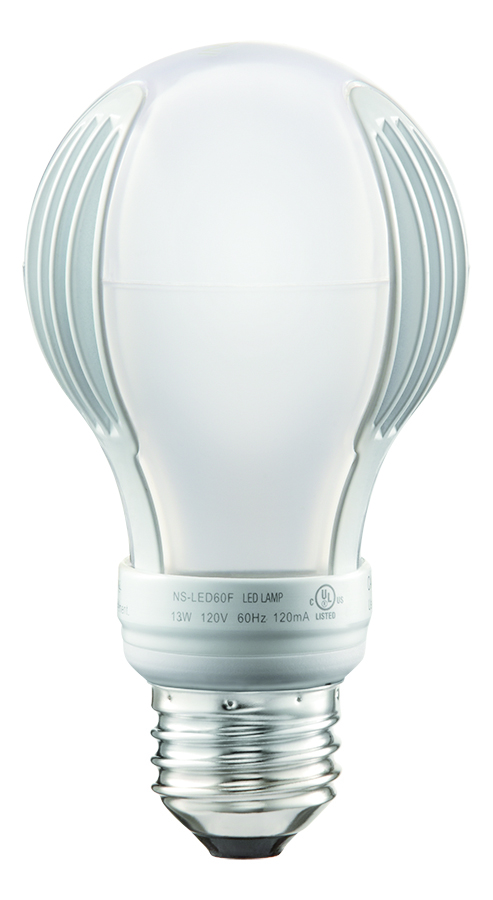LED Lighting Riding Price-Performance Curve
At first blush, expensive LED light bulbs are an unlikely technology to succeed with consumers. But the benefits of LEDs for lighting are becoming clearer, in terms of both cost reductions and high-tech features.

Best Buy last week introduced its Insignia line of consumer light bulbs in the familiar A19 shape. The bulbs use LEDs from Cree and give an amount of light equivalent to a 60-watt or 40-watt incandescent lamp. They’re designed to last over 20 years, give off a white light at 3,000 Kelvin, and have a color rendering index of 80, according to Cree.
The cost for the 60-watt equivalent, which consumes 13 watts, is $16.99, and a 40-watt-equivalent bulb costs $13.99. That’s a lot more expensive than comparable compact fluorescent or incandescent bulbs. But the Insignia shows that LED lighting costs are falling.
Two years ago, similar products from other manufacturers cost more than double what they do now. When Sylvania and Philips, for example, released their first 60-watt-equivalent LED bulb, they were priced at just under $40. Lighting Sciences Group’s 60-watt-equivalent bulbs, which also give off light in all directions, are now available at Home Depot for just under $14, according to the store’s website.
As a semiconductor technology, LED lighting has a price-performance curve much the way computer chips do, although the rate of improvement is arguably slower. And bringing the price of the popular 800-lumen bulb (about the same light as a 60-watt incandescent) closer to $10 could lead more people to consider the long-term energy savings of LEDs.
Improvements in LED light chips means brighter lights, too: next month Philips will release an LED bulb in the A21 shape, which is slightly longer than the classic incandescent bulb, that gives off as much as a 100-watt incandescent.
Still, LEDs are unlikely to undercut traditional technology on upfront price completely. That’s perhaps one reason why we’re seeing lighting manufacturers adding wireless chips to LED lamps to make premium lighting products.
Last week, Philips introduced Hue, networked LED light bulbs that can be controlled from a tablet or smartphone. (See “Apple Sells Philips’ Color-Shifting Wireless Lights.”) Another wireless LED product under development is from Lifx, a startup company trying to add multiple features, such as setting mood lighting or blinking to notify the user of new texts or tweets. (See profile in Bloomberg Businessweek.)
These smart light bulbs, which are being developed by other companies too, allow people to schedule when lights will turn on, adjust to different colors, and control lighting remotely from an Internet-connected device. IMS Research predicts that shipments of lighting with embedded radio frequency technology will balloon in the years ahead, from 600,000 units next year to 1.7 million in 2017.
These types of gee-whiz features come with a price—a four-bulb pack and Zigbee hardware hub from Philips costs about $200—and appeal to tech-savvy buyers rather than mainstream consumers. Commercial lighting customers still have a much clearer financial incentive to upgrade to LED technology because of the energy savings from better efficiency and controls.
But control from a smartphone, combined with better efficiency and longer life, sets LEDs apart from traditional lighting products. For now, it’s a niche market, but one that’s helping put LEDs on the map for consumer lighting.
Keep Reading
Most Popular
Large language models can do jaw-dropping things. But nobody knows exactly why.
And that's a problem. Figuring it out is one of the biggest scientific puzzles of our time and a crucial step towards controlling more powerful future models.
The problem with plug-in hybrids? Their drivers.
Plug-in hybrids are often sold as a transition to EVs, but new data from Europe shows we’re still underestimating the emissions they produce.
Google DeepMind’s new generative model makes Super Mario–like games from scratch
Genie learns how to control games by watching hours and hours of video. It could help train next-gen robots too.
How scientists traced a mysterious covid case back to six toilets
When wastewater surveillance turns into a hunt for a single infected individual, the ethics get tricky.
Stay connected
Get the latest updates from
MIT Technology Review
Discover special offers, top stories, upcoming events, and more.